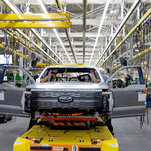
Ford Will Build a U.S. Battery Factory With Technology From China
CATL has hired thousands of engineers at low cost in a country that heavily emphasizes math and science education. The battery industry’s transformation of Ningde has echoed the boom that Detroit and Midwest experienced during the U.S. car industry’s heyday.
CATL has a third of its work force in Ningde, including many of its blue-collar workers. Rows of high-rise apartments have been built, holding down real estate prices to a tenth of those in cities like Beijing or Shanghai.
China almost completely closed its borders for nearly three years during the pandemic, preventing practically all foreigners from entering the country and limiting the ability of Chinese nationals to leave. CATL nonetheless negotiated global deals during this time, and began producing lithium-ion battery cells in December at a factory in Germany.
CATL also recently opened an office in Detroit to promote its batteries. A huge map of CATL’s worldwide operations on the wall of a lobby museum at its headquarters has a recently added dot for the Detroit office — except that the dot had been mistakenly placed in what appeared to be southwestern Wisconsin.
The process of making a lithium iron phosphate battery like the ones that Ford will be using could be seen on Sunday during a rare visit inside a cavernous CATL factory in Ningde.
The process starts with rolls of metal foil a tenth of the thickness of human hair. Aluminum foil is coated with an extremely thin layer of lithium, iron and phosphate, while copper foil is coated with an extremely thin layer of graphite. Large spools of the two kinds of foil, along with a third spool of very thin separators, are used to wind alternating layers together to make the core of each battery cell. The core is then clamped tightly together in a gray machine the size of a city bus.
A bright orange, 10-foot-tall robot, like the ones used in car assembly plant welding lines, picks up rows of battery cores and puts them into a cold press for compression. The cores then go through a kiln that heats them to 105 degrees Celsius (221 degrees Fahrenheit) to steam away any trace of water. The 300-yard-long hall in which the batteries are made is already kept much drier than even the Sahara.
After baking, liquid electrolyte — lithium salts with a solvent — is injected twice into each battery as an electrolyte. The batteries are then tightly sealed for delivery to customers.

